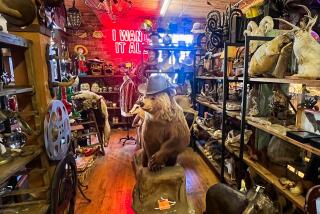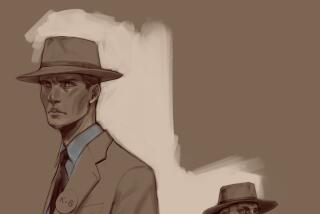A lifetime love affair with Golden Age movie posters
Think of them as snapshots of dreams, intense jolts of visual stimulation that convey the focused essence of a cinematic experience. I’m talking about movie posters, and I am almost as passionate about this art form as I am about film itself, which is saying a lot.
I’m not talking, unfortunately, about most of today’s hard-edged, photographic posters, too slick and manufactured in appearance for my taste. My preferences tend toward what’s considered the Golden Age of movie posters, roughly from the 1920s through the 1950s, the storied days of old-fashioned stone lithography and its successors, when the visual emphasis was on painting and illustration.
I’m talking about posters like 1935’s “Bordertown,” a vivid combination of color, design and emotional intensity that will take your breath away if you let it. Or 1938’s “The Dawn Patrol,” so exciting you can feel yourself in the cockpit with Errol Flynn as he goes toe to toe (or is it propeller to propeller?) with German aces in World War I.
Those images come courtesy of Mike Kaplan, a zealot for poster art who put together his massive collection — between 2,000 and 3,000 posters — over 35 years. With a day job as a producer, marketer and publicist, Kaplan had a hand in creating exceptional posters himself, most notably one for Stanley Kubrick’s “A Clockwork Orange,” and he has prized the design element above all else in his own acquisitions.
Kaplan, who now lives in Idaho, often breaks out segments of his collection for individual shows, such as 2007’s “Presenting Miss Barbara Stanwyck” in the Motion Picture Academy’s grand lobby, and a collection of dance posters that has shown in venues from Santa Monica’s California Heritage Museum to Jacob’s Pillow in the Berkshires.
It was “Gotta Dance! The Art of the Dance Movie Poster,” a new book about that part of Kaplan’s collection, that got me thinking about posters in general and what they’ve meant to me.
It started, as most things did, growing up in Brooklyn, where the captivating artwork on display at my local theaters both appealed visually and made me want to buy a ticket for the show. As Paramount founder Adolph Zukor once pointed out, “What is good art is good advertising. The most satisfying design will sell the product best.”
Owning these never crossed my mind until I stumbled across a marvelous store in San Francisco in the late ‘60s, one of the first in the country to specialize in film posters. Prices were so reasonable that even my humble entry-level pay at the Fremont News-Register (“Serving Fremont, Newark and Union City”) enabled me to buy a few.
It’s an indication of how much posters have gained in justifiable art world respectability and status that prices are reasonable no more. Just a few months ago, Heritage Auctions (the country’s largest dealer of movie posters, with $8.5 million in sales in 2014) sold a one-of-a-kind poster for Lon Chaney’s celebrated lost 1927 horror film “London After Midnight” for $478,000, a record for a movie poster sold at public auction.
That kind of interest has led to posters almost literally coming out of the woodwork, as they did with a cache of 33 extremely rare examples discovered stuck together with wallpaper paste and doing double duty as insulation in an attic in a small town in Pennsylvania.
Called “The Berwick Discovery” in tribute to that town by the shrewd marketing folks at Heritage, the posters had to be carefully steamed apart, a process that took weeks. One result was a stunning James Cagney-Jean Harlow poster for the 1931 gangster classic “The Public Enemy” that hadn’t been seen since the film’s release.
Given those prices, my poster buying days are just about over, though I did take my life into my hands a few years ago by successfully bidding in French (a language I am not exactly fluent in) at an auction held in conjunction with the Cannes Film Festival. I bought a couple of things but lost my nerve when a huge poster for “Children of Paradise” went under the hammer, and I regret it to this day.
That auction was one of the things that opened up the world of foreign language posters to me, a parallel universe that is fascinating not only because the posters differ in size from American ones but also because different countries (Poland and Belgium, of all places, are the best examples) tend to have their own distinctive visual styles.
The artistic French poster for “Le Faucon Maltais” (The Maltese Falcon) from Kaplan’s collection, for instance, has an intricate, unexpected image of the stars within a falcon as its centerpiece. And with its hint of cool eroticism, it’s not surprising that Kaplan’s poster for the George Raft-Carole Lombard “Bolero” comes from Sweden.
My increasing interest in overseas poster art as well as those escalating prices — and decreasing wall space — helped transfer my purchases from the posters themselves to heavily illustrated books on the subject. My favorite Hollywood compendium is “Reel Art: Great Posters From the Golden Age of the Silver Screen,” but I’m especially intrigued by books on what other countries have done.
Volumes I’ve come across include examinations of the movie posters of France, Italy and Mexico, specific investigations of “The Silent Film Poster: 1900-1930” and “Film Posters of the Third Reich,” as well as a slim volume titled “The Worst Movie Posters of All Time,” advertised on the cover with the promise “This book will sterilize you with fear.” Really.
You may not always have the time to see an entire movie, but a pleasing aesthetic jolt from a visually dynamic film poster is always just a glance away. The posters I own and those I see on the page convey the same emotions film does, encapsulating a feeling as well as knocking you out with their imaginative sensibility.
After decades of collecting the kind of arresting images that can make you dizzy with pleasure, Kaplan is looking for a good home for his life’s work, preferably all in one place. As a recognition of the long-neglected excellence of these stunning works, they deserve nothing less.
More to Read
Only good movies
Get the Indie Focus newsletter, Mark Olsen's weekly guide to the world of cinema.
You may occasionally receive promotional content from the Los Angeles Times.







